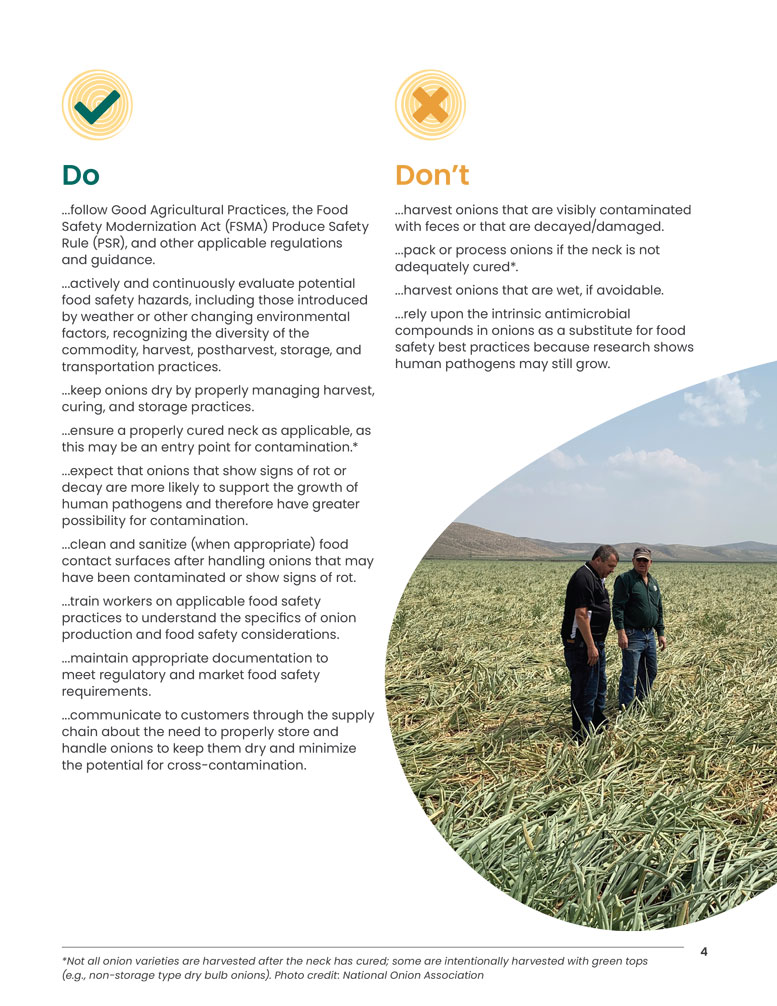|
Click to listen to this article
|
Attendees at the National Onion Association (NOA) summer convention, held July 6-9 in Boise, Idaho, were handed a “nearly final” 40-page copy of “Commodity Specific Food Safety Guidelines for the Dry Bulb Onion Supply Chain” upon registration for the convention.
This second edition of a document first written in 2010 is a collaboration between the NOA and the International Fresh Produce Association (IFPA). The two groups teamed up in response to a first ever recorded Salmonella Newport outbreak linked to U.S-grown fresh onions in 2020 and a Salmonella Oranienburg outbreak in 2021, traced to onions imported from Mexico.
Though all tests in onions for Salmonella Newport were negative in the first incident, the Food and Drug Administration (FDA) used trace-back research and found commonalities that linked back to one California farm. Agricultural water and soil samples tested positive for the pathogen on that farm.
Greg Yielding, NOA executive vice president, said new onion food safety guidelines were in the works even before the outbreaks. Though he said FDA has never proven the outbreaks came from onions, and the exact genome strain that made people sick was never found in onions, he wants onion buyers and retailers to know that the onion grower industry cares about food safety and wants to employ the best production practices relating to food safety.
Gretchen Wall, director of food safety and quality for IFPA, in her featured presentation at the convention echoed Yielding’s thoughts on best practices and said the goal of the new guidelines is to raise awareness of food safety. The guidelines can also be used to educate a wider audience about onion production, including retailers, regulators and buyers. To this aim, the new document contains information such as when particular geographic markets harvest, differences in varieties and day length, and mechanized versus hand harvesting.
The 2022 guidelines are presented in a user-friendly, practical document, and are a big improvement over the first edition. The second edition has a new focus on production and curing practices, irrigation methods and water quality, application of compounds such as sunshade, and post-harvest cleaning and sanitation practices.
Readers may also discover areas of potential concern that they may not have considered before in the new document. The new guidelines also spell out which practices are required by law, give recommendations for best practices accepted by the U.S. dry bulb onion industry, and contain a helpful “Do’s and Don’ts” chart.

Since April, the FDA has been doing on-farm onion inspection assignments for those growers subject to the Produce Safety Rule, presumably in response to the Salmonella outbreaks. Producers may be asked a series of questions specific to onions, and inspectors may also do sampling “for cause,” as Wall put it.
“I’m not entirely sure what constitutes ‘for-cause’ sampling. I would assume it would be an egregious situation – contamination directly on the produce or something of that nature,” Wall said.
Wall and Yielding agree that the onion industry has a vested interest in all onion producers adopting food safety practices. Produce pathogen outbreaks always draw a lot of negative attention. Wall said IFPA has seen outbreaks a number of times in the leafy green industry, and each time retail sales have dropped and it takes a long time for sales to rebound.
“If you haven’t thought about your compliance with the Produce Safety Rule, you should take a step back. Consider going to the grower training at the very least,” she said.
Growers at the NOA were encouraged to review the guidelines so that last-minute changes could be adopted.
Now that it is uploaded, the second edition should become the gold standard for the onion industry to produce safe product. It is available at www.freshproduce.com/resources/food-safety/commodity-specific-resources.

